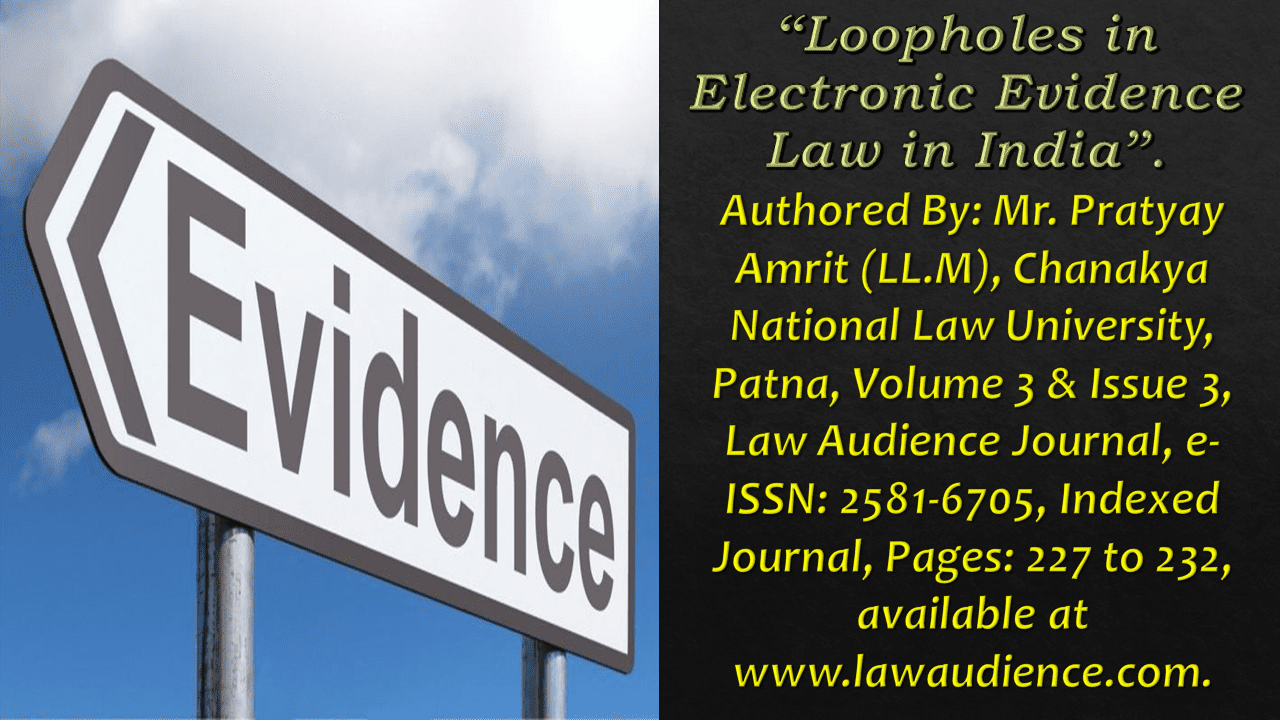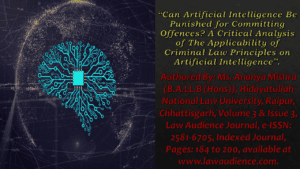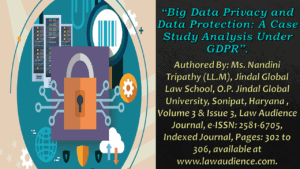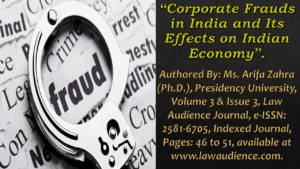Click here to download the full paper (PDF)
Authored By: Mr. Pratyay Amrit (LL.M), Chanakya National Law University, Patna,
Click here for Copyright Policy.
I. INTRODUCTION:
In view of the evolution of Computer Technology and the United Nations Commission on International Trade Law (UNCITRAL) by the modern law on electronic commerce in 1996, India being its signatory had to revise the laws. Upon the enactment of the Information Technology Act[1], 2000, Section 65A and Section 65B were added in the Indian Evidence Act[2], 1872. As per Section 3 of the Indian Evidence Act, “Evidence” means and includes all documents including electronic records produced for the inspection of the Court and thus for electronic records, documentary evidence is adduced. It is the Cardinal Principle of Indian Evidence Act or in other words, it is the Rule of Best Evidence[3], that to adduce documentary evidence, the document itself shall be produced. Primary evidence is given preference over Secondary evidence.
Thus, in cases of electronic records, primary evidence must be adduced. However, this may not be practically possible in all the cases. Section 65B (1) Indian Evidence Act creates a legal fiction and elevates a computer output, for example- printouts, pen drive etc. to the status of primary evidence by treating it as the original. However, for this the requirements of Section 65B (2) must be fulfilled. Electronic record is not defined in the Indian Evidence Act but it is defined in Section 2 (1) (t) of Information Technology Act, 2000.
II. ELECTRONIC RECORD:
Section 2 (1) (t) of the Information Technology Act, 2000 defines Electronic Record as data, record or data generated, image or sound, stored or received or sent in an electronic form or micro film or computer-generated micro fiche. Thus, any data or record or image or sound which lies in an electronic device is recognized as electronic record. For example, conversation recorded on mobile phone, email, defamatory comments on live chat etc. For electronic records documentary evidence needs to be adduced in primary form, not oral evidence. So, if something is there in laptop then primary evidence is the document itself i.e., the laptop. But it is not possible to submit the laptop in Court and hence to deal with this situation Section 65A and Section 65B Indian Evidence Act are there.
II.I SECTION 65A INDIAN EVIDENCE ACT:
The contents of electronic records should be proved in accordance with the provisions of Section 65B[4].
II.II SECTION 65B INDIAN EVIDENCE ACT:
Information contained in electronic record which can be printed on a paper or stored, recorded, copied in optical or magnetic media shall be considered Document i.e., original itself, if other conditions of Section 65B are fulfilled specially Sec.65B (2) and shall be admissible in any proceedings without further proof or production of the original. For example, a print out of a case law from SCC Online will be regarded as original (primary evidence) if conditions of Sec. 65B (2) are fulfilled. By creating the legal fiction in this section, the legislature is trying to make the secondary evidence as good as primary evidence.
The purpose of Sec. 65B (2) is to ensure authenticity of the computer output and it contemplates a situation where the electronic record is or has been in possession of person adducing electronic evidence, and the conditions shall be namely;
- The computer output containing the information was produced by that computer which was regularly being used for that very purpose by the person having lawful control over the use of the computer.
- During that period, information of the same kind was regularly fed into the computer in the ordinary course of such activities.
- During that period the computer was operating properly and if the computer was faulty for some time, then it does not affect the computer output so obtained.
- The information contained in the electronic record is derived from such information fed into the computer.
Any documentary evidence by way of an electronic record under the Indian Evidence Act, in view of Sec. 65A can be proved only in accordance with procedure established under Sec. 65B. Section 65B deals with admissibility of electronic record. The purpose of these provisions is to sanctify secondary evidence in electronic form generated by computer[5]. Section 65B starts with a non-obstante clause. Thus, notwithstanding anything contained in the Indian Evidence Act, any information contained in an electronic record which is printed on a paper, stored or recorded or copied in an optical or magnetic media produced by a computer shall be deemed to be a document only if the conditions of Sec.65B (2) are satisfied. If these conditions are satisfied, there is no requirement of any further proof by production of the original. The very admissibility of such a document i.e., electronic record which is called as ‘computer output’ depends upon the satisfaction of 4 conditions given in sec.65B (2)[6].
Under Section 65B (4), if it is desired to give a statement in any proceeding pertaining to an electronic record, it is permissible upon furnishing a Certificate containing any of the following;
- The Certificate identifying the electronic record containing the statement.
- The Certificate describing the manner in which the electronic record was produced.
- The Certificate furnishing the particulars of the device involved in the production of that record.
- The Certificate dealing with the applicable conditions mentioned in Sec. 65B (2).
- The Certificate must be signed by a person occupying a responsible official position in relation to the operation of the relevant device.
Section 65B (4) further clarifies that the person needs only to state in the certificate that the same is to the best of his knowledge and belief. All these safeguards are taken to ensure the source and authenticity which are the two hallmarks pertaining to electronic record sought to be used as evidence. However, there are certain ambiguities in the interpretation of Section 65B (4). There have been contradicting judicial opinions with respect to the requirement of the Certificate. For this, we need to understand the journey from Navjot Sandhu case to the decision in Arjun Panditrao case.
III. CONTRADICTING JUDICIAL OPINIONS WITH RESPECT TO THE REQUIREMENT OF CERTIFICATE:
In State (NCT of Delhi) vs. Navjot Sandhu @ Afsan Guru[7], it was held that irrespective of the compliance with the requirements of Section 65B, there is no bar to producing secondary evidence under other provisions of the Indian Evidence Act Namely Sec. 63 and Sec. 65. However, this judgment was overruled by a 3 Judge-bench of the Supreme Court in Anvar P. V. case.
In Anvar P. V. vs. P. K. Basheer[8], it was held that the very caption of Sec. 65A Indian Evidence Act read with Sec. 59 read with Sec. 65B is sufficient to hold that the special provisions on evidence relating to electronic record shall be governed by procedure given in Sec. 65B Indian Evidence Act. It was further held that Sec.65A and Sec. 65B are a complete code. Sec. 65A and Sec. 65B being the special provisions will prevail over the general provisions contained in Sec. 65 and Sec. 63. The Evidence Act does not provide for or permits the proving of an electronic record by oral evidence if the conditions of Sec. 65B are not fulfilled. The legal position held in Anvar P. V. case seemed to be incorrect particularly in cases where the electronic device was in possession of a third party.
In Tomaso Bruno vs. State of U. P[9], the Supreme Court relied on Navjot Sandhu case and ignored Anvar P. V. judgment. So, presently this judgment is not considered as a good judgment.
In Sonu @ Amar vs. State of Haryana[10], it was iterated by the Supreme Court that requirement of Certificate is at trial stage and not at appellate stage. This judgment talked about the issue of prospective overruling but did not clarify it and thus this judgment is also criticized. A corollary of the Sonu @ Amar judgment is that if a real objection to the mode of proof of an electronic record is overruled by the trial court, or if a bogus objection[11] is upheld during trial, the case’s conclusion may be negatively influenced, leading to a miscarriage of justice. It could potentially result in the matter being remanded in court.
Therefore, a 2 Judge-bench in the case of Shafhi Mohammad vs. State of Himachal Pradesh[12], tried to give a clarification in this issue. In this case, it was held that the applicability of procedural requirement under Sec. 65B (4) of furnishing Certificate is to be applied only when such electronic evidence is produced by a person who is in a position to produce such certificate being in control of the said device and not of the opposite party or any third party. In cases where the device is in possession of a third party, the applicability of Sec. 63 and Sec. 65cannot be excluded. Thus, it was held that Certificate is not mandatory in all the cases. It can be understood from the Shafhi Mohammad case that where a certificate can be possibly given, it is mandatory. However, if a certificate cannot be given because the device in question was in possession of a third party, in such cases the Certificate is not required and the document can be proved as per Sec. 63 and Sec. 65. However, this judgment laid to some uncertainties as it gave the trial court discretion to require or not to require the certificate. Thus, this issue was referred to a larger bench in Arjun Panditrao case.
In Arjun Panditrao Khotkar vs. Kailash Kushanrao Gorantyal[13], the Supreme Court held that the requirement of Certificate is mandatory. It was further held that Sec. 65B (4) is cumulative i.e., all the requirements in Sec. 65B (4) and the corresponding requirements in Sec. 65B (2) must be fulfilled. The Court further held that the view taken by Shafhi Mohammad is incorrect as it cannot be said that in some cases certificate is mandatory and in some cases it is not. It was further held that even if the certificate cannot be produced because of the device being in possession of a third person, the Court has special powers under various provisions like Sec. 165 Indian Evidence Act[14], OXVI Code of Civil Procedure[15], Sec. 91 Criminal Procedure Code[16] etc. to call for the Certificate from any person or witness.
The view taken by Arjun Panditrao case also results in a number of ambiguities. The intention of the Legislature was never to make the requirement of Certificate a hurdle in justice delivery. The use of the word ‘may’ in Sec. 65A and ‘desired’ in Sec. 65B (4) suggests that the intention of the legislature was not to make this requirement so rigid. Also, with respect to the requirement of all the conditions given in Sec. 65B (4) to be followed, it is against the use of the word ‘any’ in Sec. 65B (4). Also, the Court has failed to examine as to who will give the Certificate in cases falling under Sec. 65B (3) and Sec. 65B (5). Till date, the Court has never considered the point that if there is no human intervention then who will furnish the Certificate.
IV. CONCLUSION:
Today’s biggest issue for Courts dealing with electronic evidence is ensuring its validity, veracity, sincerity, and trustworthiness in order for it to be admitted in court. However, since the Information Technology Act of 2000 granted legal legitimacy to electronic or digital evidence, as well as later amendments to the Indian Evidence Act of 1872, the use of electronic evidence has progressed a lot. However, the statutory measures enacted to test the authenticity of electronic evidence are insufficient to address the issues that arise as a result of malpractices such as information falsification in connection to the legality of information used as evidence during trials or procedures. In order to deal with this issue, it may be appropriate to set up a team of experts who are well-versed with the tools of information technology. The Ministry of Electronics and Information Technology has taken an initiative by acknowledging the need for appointing an expert of electronic evidence who will assist the prosecutors and investigators. Section 79A of Information Technology Act, 2000 empowers the Central government to appoint “Examiners of Electronic Evidence”.
Cite this article as:
Mr. Pratyay Amrit, “Loopholes in Electronic Evidence Law in India”, Vol.3 & Issue 3, Law Audience Journal (e-ISSN: 2581-6705), Pages 227 to 232 (2nd February 2022), available at https://www.lawaudience.com/loopholes-in-electronic-evidence-law-in-india/.
Footnotes & References:
[1] Information Technology Act, 2000, No. 21, Acts of Parliament, 2000 (India).
[2] The Indian Evidence Act, 1872, No. 01, 1872 (India).
[3] 19 Willamette L. Rev. 427 (1983).
[4] Indian Evidence Act, 1872.
[5] Steven Goode, The Admissibility of Electronic Evidence, 29 Rev. Litig. 1 (2009).
[6] https://rmlnlulawreview.com/2017/08/25/pv-anvar-v-pk-basheer-a-critique/.
[7] (2005) 11 SCC 600 (India).
[8] (2014) 10 SCC 473 (India).
[9] (2015) 7 SCC 178 (India).
[10] (2017) 8 SCC 570 (India).
[11] James Fitzjames Stephen, “The Indian Evidence Act with an Introduction on the Principles of Judicial Evidence” (Macmillan & Co., 1872).
[12] SLP (Crl.) No. 2302 of 2017.
[13] (2020) 7 SCC 1 (India).
[14] Supra note 2.
[15] Code of Civil Procedure, 1908, No. 5 of 1908.
[16] Code of Criminal Procedure, 1973, No. 2 of 1974.



